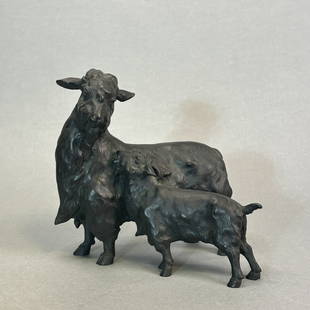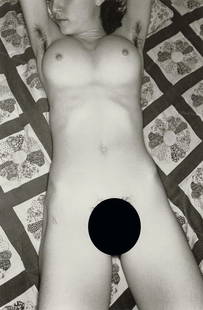
Museum Japanese bronze mirror: Two cranes, Edo
Similar Sale History
View More Items in Sculptures & CarvingsRelated Sculptures & Carvings
More Items in Edo Sculptures & Carvings
View MoreRecommended Art
View More









Item Details
Description
Museum Japanese bronze mirror: Two cranes and tree,- Edo Emperor period (1600-1868). Exceptional quality mirror surface you can see your real reflection almost like in a modern mirror; Diameter: 7 1/8" inches = 182 mm = 18.2 cm; Length with a handle: 11 1/4" inches = 283 mm = 28.3 cm; Weight: 2 lb. = 900 g; Condition: some rust and patina, handle still have remnants of original cover. The hay cover on the handle is partially missing. Japanese bronze mirrors Bronze mirrors were introduced into Japan from China and Korea during the Yayoi period (about 300 BC - AD 300). At first they had a religious function and were regarded as symbols of authority. The Japanese soon learnt to make their own mirrors using the lost-wax technique, decorating them with Chinese or native Japanese designs. By the Nara period (AD 710 -794) mirrors were being made for everyday use, with the increasing use of Japanese designs, such as native plants and animals symbolizing good fortune. From the Kamakura period (1185-1333) a design showing Hôraizan (the Chinese 'Island of Immortality') became popular. Mirrors gradually became more robust. They mostly have a central boss, often in the shape of a tortoise, which was pierced and a cord passed through for holding. More new designs and the first handled mirrors appeared in the Muromachi period (1333-1568). During the Edo period (1600-1868), mirrors decorated with lucky symbols or Chinese characters were given at weddings. Mirrors became larger as hairstyles became more ornate; some mirrors in Kabuki theatre dressing-rooms were up to fifty centimeters across and were placed on stands. The faces of mirrors were highly polished or burnished, with itinerant tanners and polishers specializing in this work. Since the mirror, together with the sword and the jewel, were symbols of Imperial power, mirror-makers were deeply revered and often given honorary titles such as Tenka-Ichi ('First under Heaven'). However, this title was often misused and was officially prohibited in 1682. Bronze mirrors were replaced by glass mirrors after the Meiji Restoration (1868). Edo period (1600-1868); Exceptional quality mirror surface you can see your real reflection almost like in a modern mirror; Diameter: 7 1/8" inches = 182 mm = 18.2 cm; Length with a handle: 11 1/4" inches = 283 mm = 28.3 cm; Weight: 2 lb. = 900 g; Condition: some rust and patina, handle still have remnants of original cover. The hay cover on the handle is partially missing. Japanese bronze mirrors Bronze mirrors were introduced into Japan from China and Korea during the Yayoi period (about 300 BC - AD 300). At first they had a religious function and were regarded as symbols of authority. The Japanese soon learnt to make their own mirrors using the lost-wax technique, decorating them with Chinese or native Japanese designs. By the Nara period (AD 710 -794) mirrors were being made for everyday use, with the increasing use of Japanese designs, such as native plants and animals symbolizing good fortune. From the Kamakura period (1185-1333) a design showing Hôraizan (the Chinese 'Island of Immortality') became popular. Mirrors gradually became more robust. They mostly have a central boss, often in the shape of a tortoise, which was pierced and a cord passed through for holding. More new designs and the first handled mirrors appeared in the Muromachi period (1333-1568). During the Edo period (1600-1868), mirrors decorated with lucky symbols or Chinese characters were given at weddings. Mirrors became larger as hairstyles became more ornate; some mirrors in Kabuki theatre dressing-rooms were up to fifty centimeters across and were placed on stands. The faces of mirrors were highly polished or burnished, with itinerant tanners and polishers specializing in this work. Since the mirror, together with the sword and the jewel, were symbols of Imperial power, mirror-makers were deeply revered and often given honorary titles such as Tenka-Ichi ('First under Heaven'). However, this title was often misused and was officially prohibited in 1682. Bronze mirrors were replaced by glass mirrors after the Meiji Restoration (1868).
Condition some rust and patina, handle still have remnants of original cover. The hay cover on the handle is partially missing.
Low Estimate: 2000;
High Estimate: 40000;
Original: Yes;
Condition some rust and patina, handle still have remnants of original cover. The hay cover on the handle is partially missing.
Low Estimate: 2000;
High Estimate: 40000;
Original: Yes;
Buyer's Premium
- 0%
Museum Japanese bronze mirror: Two cranes, Edo
Estimate $2,000 - $4,000
Get approved to bid.
Shipping & Pickup Options
Item located in Tampa, FL, usSee Policy for Shipping
Payment

TOP



































































